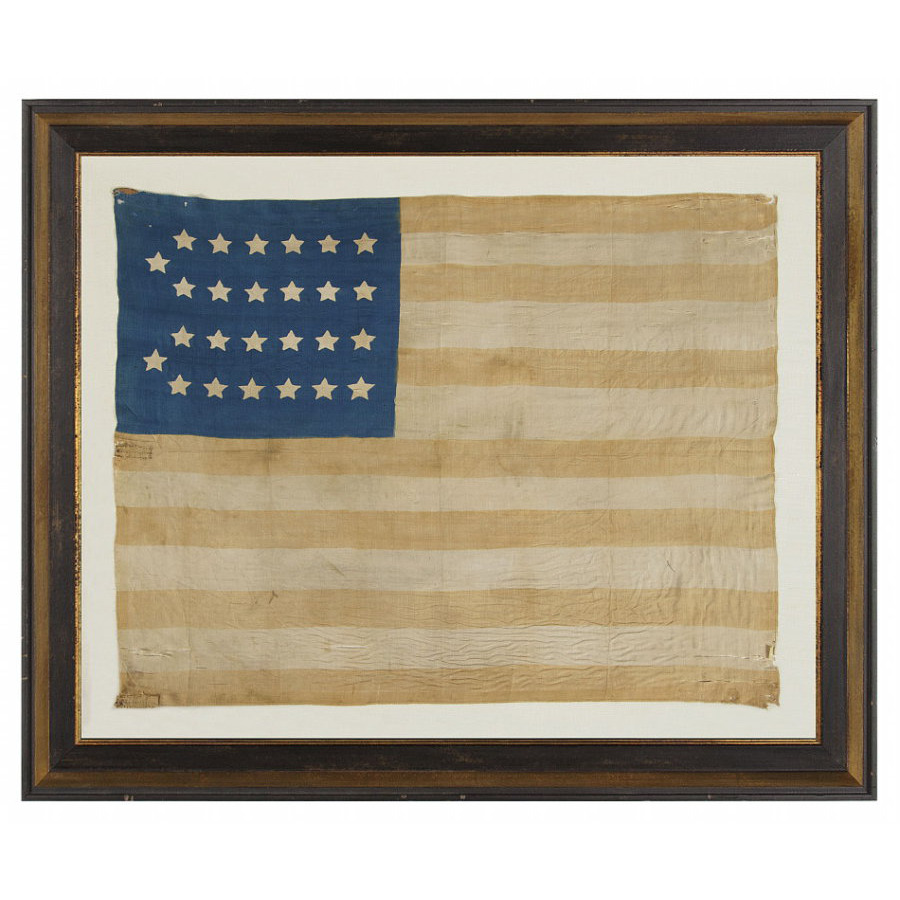
| |
EXTREMELY RARE, SILK, ANTIQUE AMERICAN PARADE FLAG WITH 26 STARS, THE EARLIEST KNOWN STAR COUNT FOR PRINTED EXAMPLES, 1837-1846, MICHIGAN STATEHOOD |
|
| Available: |
Sold |
| Frame Size (H x L): |
Approx. 39.5" x 47" |
| Flag Size (H x L): |
28.5" x 36" |
|
| Description....: |
|
EXTREMELY RARE, SILK, ANTIQUE AMERICAN PARADE FLAG WITH 26 STARS, THE EARLIEST KNOWN STAR COUNT FOR PRINTED EXAMPLES, 1837-1846, MICHIGAN STATEHOOD:
26 star American parade flag, printed on silk, with 4 rows of 6 stars and 2 stars offset before them at the hoist end of the canton. These roughly form two exaggerated "C's", a design that is seldom seen in any star count. It has been suggested that this might actually form the letter "M" (tipped ninety degrees) for Michigan, which became the 26th state to join the Union on January 26th, 1837. While this may not have been the intended purpose of the arrangement, it remains an interesting speculation and whatever the case may be, this seems to have been a popular way to arrange 26 stars.
The 26 star flag became official on July 4th, 1837, and remained so until the addition of the 27th state in 1845. The earliest known parade flags have either 26 or 13 stars, the latter made during this same general time frame with patriotic respect for our colonial past. 26 is a rare star count and only a small number of flags are known to exist. Most printed examples have printed, political advertising for the presidential campaign of William Henry Harrison (1840), Henry Clay or James Polk (1844). The remainder, including this flag, survive among less than 20 known examples. Most of these are more square in shape when compared to modern flags. Their profile may reflect the silk militia flags and regimental banners that were in use during the 18th and 19th centuries and would have simultaneously allowed women to use the flags as scarves to drape over their bonnets at parades or political rallies. Most that I have encountered, however, were at some point tacked to staffs in traditional parade flag format. That is the case with this particular example, which has hand-sewn reinforcements at three equally spaced points along the hoist.
Approximately five flags are currently known to exist from this particular manufacturer, the name of which is unknown. All have nearly square proportions and are nearly identical in size, made of the same grade of silk, and bear the same "Double-C" star configuration (though one displays it in a mirror image, with the 2 offset stars located toward the fly instead of the hoist). One of the four is printed in waving format, with appropriate shadowing and a printed image of a whimsical staff along the hoist end. The others are flat, like most all other known parade flags. One is cotton and the remainder are silk.
The fact that the canton rests on a red stripe is a very rare trait. Some flag historians refer to this as the "blood stripe" or the "war stripe", suggesting the flag was sometimes constructed in this manner when the nation was at war. There is also evidence that the Navy used this design feature on at least some of its flags made during the mid-19th century and sometimes the placement was undoubtedly by accident. In any event, the war stripe feature is highly desired among collectors and enthusiasts and is particularly rare in printed flags.
The combination of the very early date, unusual star configuration, war strip feature, and rarity of flags in the 26 star count combine to make this a fantastic example.
Mounting and Framing: Included in the price.
Condition: There is significant fading of the red stripes to salmon and there is minor soiling throughout. The flag was obviously flown for an extended period and shows signs of this in the expected places, including the top and bottom the fly end and the general areas surrounding the three points along the hoist where the reinforced tabs allowed it to be attached to a staff. There are minor lateral splits elsewhere. The blue and red dyes usually helped to stabilize the fabric in the respective areas where it was applied and this was the case here. The flag presents tremendously well and its great rarity warrants practically any condition. |
|
|
|
| Collector Level: |
Flags for the truest Patriots. My best offerings |
|
| Flag Type: |
Parade flag |
|
| Star Count: |
26 |
|
| Earliest Date of Origin: |
1837 |
|
| Latest Date of Origin: |
1845 |
|
| State/Affiliation: |
Michigan |
|
| War Association: |
1777-1860 Pre-Civil War |
|
| Price: |
SOLD |
|
| |
Views: 3026 |
|
|
|

